Tourists swarmed back to Maine this summer, reversing a downturn in 2020 and surpassing the amount of pre-pandemic visitors and spending.
Visitation data released this week by the Maine Office of Tourism shows what businesses and residents already knew – even as the coronavirus circulates widely, people still want to travel to Maine.
“We may be on course for 16 to 18 million visitors this year, dramatically higher than 2020, but also higher than 2019,” Phillip Downs, a senior partner at Downs and St. Germain Research, said during a presentation to the Maine tourism industry this week.
Downs and St. Germain, a Tallahassee, Florida, firm, has a contract with Maine to survey tourists and report visitor and spending data, among other research. The firm interviewed almost 3,000 travelers in 70 locations for its research.
Based on those surveys, it estimates more than 10 million people traveled in Maine – either from out of state or another part of the state – between May and August, the height of the state’s tourism season. By comparison, about 6.7 million people traveled in Maine over the same period in 2020. At the time, many businesses in Maine were under tight public health restrictions, and leisure travel from almost every other state was constrained.
That visitor numbers rebounded strongly in 2021 should be no surprise. The state dropped all travel restrictions and most public health measures in May, and travelers were ready to travel again.
But visitation this summer also was higher than in 2019, when about 9.8 million people traveled the state.
Spending rebounded, too. In the first seven months of the year, patrons spent more than $2.5 billion at Maine restaurants, hotels and other lodging businesses, according to the most recent sales reports from Maine Revenue Services.
That was almost $1 billion more than the same period in 2020, and higher than the $2.3 billion spent during those months in 2019.
Overall tourism spending figures will not be available until the Maine Office of Tourism’s annual report is released next year. But even in 2020, spending reached $9 billion and supported 90,000 jobs, Downs said.
Shifts in the kinds of people who visited this summer indicate that travel is returning to some version of normal, he added.
Last summer, as Maine cautiously emerged from a stay-at-home order triggered by the first coronavirus wave, 35 percent of tourists in the state were Mainers who traveled more than 50 miles from home, according to Downs’ research.
This summer, Maine residents accounted for just 16 percent of tourists. More than half of all visitors came from just four other states: Massachusetts, New York, New Hampshire and Florida.
SEAFOOD A TOP ATTRACTION
But there were plenty of travelers from further afield, including the Southeast, West and Midwest, Downs said.
“This is a sea change from last year,” he said. “Last year, 83 percent of visitors came from New England. This year it is 44 percent. (From) the Southeast, only 1 percent came last year – this year it was 13 percent.”
Downs said his firm is beginning to see a “return to normalcy” and even an expansion of markets from which Maine visitors are arriving.
Despite long lines, shortened hours, slower service and fewer amenities triggered by acute staffing challenges this summer, people apparently had a good time. Ninety-five percent of those interviewed said they would return to the state, and 97 percent said they would recommend it to a friend or family member, Downs reported.
And what are all those people doing when they come to Maine? Eating and drinking, apparently. Sixty-four percent of respondents said their top activity was food, beverage or culinary, and 42 percent said they ate lobster while in the state.
“They love to eat when they come to Maine,” Downs said. “They love lobster and the local seafood – it is the No. 1 visitor activity.”
Send questions/comments to the editors.




Success. Please wait for the page to reload. If the page does not reload within 5 seconds, please refresh the page.
Enter your email and password to access comments.
Hi, to comment on stories you must . This profile is in addition to your subscription and website login.
Already have a commenting profile? .
Invalid username/password.
Please check your email to confirm and complete your registration.
Only subscribers are eligible to post comments. Please subscribe or login first for digital access. Here’s why.
Use the form below to reset your password. When you've submitted your account email, we will send an email with a reset code.